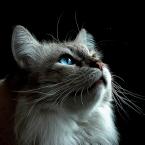Feline Acne
Can be treated with fatty acids but perhaps the best treatment is with Vitamin E
Feline acne is becoming a lot more common, there are several conditions that can cause it, but there are also several remedies for it.
However, just like with humans, most all acne can be traced back to what is in your cat’s diet or what is lacking in their diet.
Most acne conditions in your cat will be localized around either your cats chin or lips, centering on the sebaceous glands.
It most always starts as a small black and oily spot and is very similar to blackheads in humans.
If these blackheads become inflamed they turn into feline ache. This condition can and does affect cats of all ages and all breeds; but it does seem to affect Persian cats more severely.
THE CAUSES OF FELINE ACNE
There may be several causes for feline acne but what has happened is that the hairs in the pores of your cat have become blocked because of these glands.
The sebaceous glands produce a substance called sebum that protects your cat’s skin by lubricating it.
 Fatty acids and Vitamin E in their diet is very helpful
Fatty acids and Vitamin E in their diet is very helpfulA suppressed immune system could cause poor secretion of these glands, or there may be a type of atopic dermatitis in your cat that is actually producing way too much oil.
It could also be poor grooming conditions by your cat as well as being triggered by allergies.
There are also some that believe that feline acne may be caused an allergic reaction by your cat to their feeding and watering bowels, but that is not very likely.
FATTY ACIDS CAN HELP
The most likely cause of acne in your cat will be their diet.
For decades, fatty acids have proven to be extremely important in your cat’s hair coat, providing it with gloss and health.
But several veterinarians are starting to fully understand the role these acids play in preventing allergies and inflammation in your pet’s skin.
In most all cases of feline acne the major cause is inflammation of the glands.
The omega 3 form of fatty acids is not nearly as abundant in most commercial foods, and it is extremely important to keep the ratio of omega 6 and omega 3 in the proper proportion.
What is also important to understand is that fatty acids can actually degrade over time.
A very simple solution to this and perhaps end the acne in your cat, is to supplement one Vitamin E capsule in your pets food. It fortifies the omega fatty acids and also helps to fight the inflammation.
THE SYMPTOMS AND TREATMENTS
The first symptom that your cat may be developing feline acne is the appearance of dirt on their chin, or it looks like dirt. This is actually the comedones or blackheads developing.
When they abscess or actually break open it will form a crust that looks like dirt.
If it is severe enough your cat will develop draining tracks that will lead to hair loss and swelling on their chins.
It can also cause your cat to scratch their skin repeatedly as it becomes extremely itchy to them.
This is something all owners should watch for as excessive itching can lead to several forms of bacterial infection.
No one knows the exact reason why, but Persian cats also face the risk of acne spreading to other parts of their skin, especially their skin folds.
If you own a Persian, watch their folds very close.
Making sure your cat is getting the essential fatty acids they need as well as fortify them with Vitamin E is the best treatment. This condition is said to be treatable, but never cured.
However, if the glands do not secret beyond normal, it becomes very controllable.
Oral topics will also help especially if there is a bacterial infection.
If your cat is allergic to their eating or drinking dish, using a very shallow dish may help as it will eliminate the contact with the dish.
Gently cleaning your cats affected areas with an antibiotic soap, hydrogen peroxide, or Epsom salts is also very effective.
Ointments such as benzoyl peroxide are also very good and most all forms of human treatments for acne have this same ingredient.
If it is a very severe case of feline acne, you may have to use an antibacterial soap on your pet at least two to three times a week to bring it under control.
You may also want to try acne cleaning pads to cleanse your cats chin a couple of times each week.
Shaving your cats chin may also prove to be necessary to keep it clean all of the hair follicles in severe cases.
Summery
In most all case of feline acne it starts and ends with the diet and cleaning habits. It is not a lot different than in human forms of acne.
Cleaning and eating properly can control this condition very easily.
Pet Medications for Feline Acne
Cat Vitamin Store
Rippling Skin Disease in Cats








